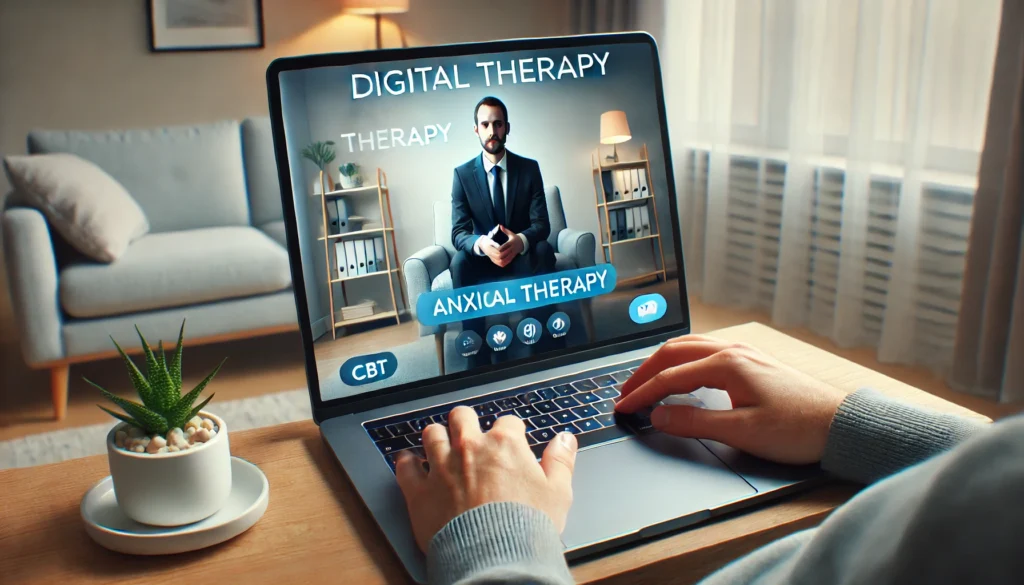Anxiety is a natural human response, a mechanism designed to alert us to potential danger. However, when this response becomes chronic, it can interfere with daily life, leading to disorders such as Generalized Anxiety Disorder (GAD), panic disorder, and severe anxiety episodes. Understanding the impact of anxiety on mental and physical health is the first step in exploring how to manage it effectively.
You may also like: Natural Supplements for Effective Anxiety Relief

The Nature of Anxiety
Anxiety is a complex emotion that is part of the body’s natural defense system. It prepares us to face challenges, alerting us to potential threats. This response, while protective, can become maladaptive when triggered by non-threatening situations, leading to chronic stress and anxiety disorders. Recognizing the beneficial aspects of anxiety can aid individuals in managing their responses more effectively.
Anxiety Disorders and Their Symptoms
Anxiety disorders manifest in various ways, each with unique symptoms. Generalized Anxiety Disorder involves persistent and excessive worry, while panic disorder is marked by sudden, intense fear episodes. Social anxiety disorder impacts social interactions, causing significant distress. Understanding these disorders helps in identifying the specific symptoms and developing targeted treatment strategies.
The Consequences of Chronic Anxiety
Chronic anxiety can lead to a host of physical and mental health issues. Physically, it can contribute to cardiovascular problems, weakened immune response, and gastrointestinal issues. Mentally, it can cause depression, decreased cognitive function, and a diminished quality of life. Addressing anxiety is crucial not only for mental well-being but for overall health.
The Science Behind Anxiety
Anxiety disorders are characterized by excessive fear and worry. They activate the body’s fight-or-flight response, releasing stress hormones like adrenaline and cortisol. These hormones can lead to physical symptoms such as increased heart rate, rapid breathing, and heightened alertness, which, if persistent, can take a toll on one’s overall health.
Hormonal Response to Anxiety
When faced with anxiety-inducing stimuli, the body’s immediate response is to release stress hormones. Adrenaline prepares the body for immediate action, while cortisol maintains heightened alertness. Understanding these hormonal responses is essential for developing strategies that can mitigate their effects and reduce anxiety.
Neurological Pathways in Anxiety
The brain’s amygdala and prefrontal cortex play significant roles in anxiety. The amygdala processes threats and triggers fear responses, while the prefrontal cortex regulates these responses through rational thinking. Disruptions in this balance can lead to heightened anxiety, emphasizing the need for therapeutic interventions that target these neural pathways.
Long-term Health Implications
Persistent activation of the fight-or-flight response can lead to significant health problems. Long-term exposure to stress hormones can impair cardiovascular health, increase susceptibility to infections, and exacerbate mental health disorders. By understanding these implications, individuals can prioritize addressing anxiety to prevent these adverse outcomes.
Cognitive Behavioral Therapy: A Non-Pharmaceutical Approach
CBT is a structured, time-limited therapy that addresses the interplay between thoughts, emotions, and behaviors. By understanding and altering negative thought patterns, individuals can reduce anxiety symptoms and improve their quality of life.
Core Principles of CBT
CBT focuses on challenging and changing unhelpful cognitive distortions and behaviors, improving emotional regulation, and developing personal coping strategies that target solving current problems. Its effectiveness is well-documented, making it a preferred choice for those seeking non-drug treatments for anxiety.
Cognitive Restructuring
Cognitive restructuring involves identifying irrational thoughts and beliefs that fuel anxiety. By challenging these thoughts and replacing them with realistic perspectives, individuals can alleviate anxiety. This process requires self-reflection and an understanding of cognitive biases that distort perception.
Behavioral Interventions
CBT also incorporates behavioral techniques to address anxiety. This includes engaging in activities that promote positive emotions and avoiding behaviors that exacerbate anxiety. By changing behavior patterns, individuals can influence their emotional responses, leading to reduced anxiety over time.
Emotional Regulation Strategies
Effective emotional regulation is a cornerstone of CBT. Techniques such as deep breathing, mindfulness, and progressive muscle relaxation are employed to manage emotional responses. By practicing these techniques, individuals can prevent anxiety from escalating, maintaining calm even in stressful situations.
Techniques Used in CBT for Anxiety
1. Cognitive Restructuring: This involves identifying and challenging irrational thoughts that fuel anxiety. By restructuring these thoughts, individuals can shift their perspective and reduce anxiety levels.
- Identifying Cognitive Distortions: Recognizing patterns such as catastrophizing or overgeneralizing can help individuals see the reality of situations more clearly.
- Replacing Negative Thoughts: Developing alternative, positive thoughts helps in creating a balanced outlook, reducing anxiety.
- Practicing Thought Journaling: Keeping track of thoughts and emotions over time assists in identifying triggers and developing effective coping strategies.
2. Exposure Therapy: Gradual exposure to anxiety-provoking situations helps individuals build tolerance and reduce fear over time. This technique is particularly effective for panic disorder treatment without medication.
- Understanding the Fear Hierarchy: Creating a list of feared situations and gradually facing them can desensitize individuals to anxiety triggers.
- Virtual Reality in Exposure: Utilizing VR technology can simulate anxiety-provoking environments, providing safe and controlled exposure.
- Monitoring Progress: Tracking responses to exposure helps in understanding improvements and adjusting treatment plans accordingly.
3. Mindfulness and Relaxation Techniques: Incorporating mindfulness practices helps individuals stay grounded and focused in the present, reducing the tendency to worry about future events.
- Mindful Breathing: Focusing on breath helps in calming the mind and reducing anxiety.
- Progressive Muscle Relaxation: This technique involves tensing and relaxing muscle groups to release physical tension.
- Guided Imagery: Visualizing peaceful and calming scenes can distract from anxiety-inducing thoughts, promoting relaxation.

Historical Context and Evolution of CBT
CBT has its roots in the early 20th century with the work of psychologists like Aaron Beck and Albert Ellis. Over the decades, it has evolved, integrating various approaches to become a comprehensive framework for treating anxiety and other mental health disorders.
The Rise of CBT
The effectiveness of CBT in treating anxiety without medication lies in its empirical foundation. Numerous studies have demonstrated its success in reducing symptoms of GAD, panic attacks, and other anxiety disorders, making it a cornerstone of psychological treatment today.
Pioneers of CBT
Aaron Beck and Albert Ellis were instrumental in developing CBT. Beck’s cognitive theory focused on the impact of thoughts on emotions, while Ellis’s Rational Emotive Behavior Therapy emphasized challenging irrational beliefs. Their work laid the groundwork for modern CBT practices.
CBT’s Empirical Validation
Research has consistently validated CBT’s effectiveness across various anxiety disorders. Clinical trials have shown significant improvements in anxiety symptoms, making it a trusted intervention. This empirical support has led to its widespread adoption in therapeutic settings.
Global Adoption and Adaptation
CBT has been adapted globally to address cultural differences in anxiety experiences. Therapists have modified techniques to suit diverse populations, ensuring its relevance and effectiveness. This adaptability has contributed to its global popularity as a treatment for anxiety.
Current Trends in CBT
Recent advancements have seen the integration of technology with CBT, such as the development of online CBT platforms and mobile applications. These innovations have made CBT more accessible, allowing individuals to engage in therapy remotely, which is particularly beneficial for those with severe anxiety who may find it challenging to attend in-person sessions.
Digital CBT Platforms
The rise of digital platforms has democratized access to CBT. Online therapy sessions and mobile applications provide flexible and affordable options for individuals seeking help. These platforms also offer interactive tools and resources, enhancing the therapeutic experience.
Teletherapy and Remote Sessions
Teletherapy has become a viable option for those unable to access in-person therapy. It allows for continuity of care, enabling individuals to connect with therapists from anywhere. This is particularly beneficial for those with mobility issues or residing in remote areas.
Innovations in CBT Delivery
Innovations such as virtual reality and AI-driven therapy are shaping the future of CBT. VR offers immersive exposure therapy experiences, while AI can provide personalized feedback and support. These technological advancements promise to enhance the effectiveness and reach of CBT.
Practical Advice for Implementing CBT Techniques
For those wondering “how can I control anxiety without medication?”, incorporating CBT techniques into daily life can be transformative. Here are some practical steps:
1. Journaling: Keep a thought diary to identify triggers and negative thought patterns.
- Daily Reflection: Writing down daily thoughts and emotions helps in recognizing patterns and triggers.
- Mood Tracking: Documenting mood changes can reveal connections between thoughts and feelings.
- Goal Setting: Journaling can be used to set and track progress towards personal goals, promoting motivation and achievement.
2. Breathing Exercises: Practice deep breathing techniques to calm the nervous system during anxiety episodes.
- Diaphragmatic Breathing: Focusing on deep belly breaths can activate the body’s relaxation response.
- Box Breathing: This technique involves inhaling, holding, exhaling, and pausing for equal counts, promoting calmness.
- Resonant Breathing: Breathing at a consistent rhythm can synchronize the heart rate, reducing anxiety.
3. Set Realistic Goals: Break down tasks into manageable steps to reduce overwhelm and build confidence.
- Prioritization: Identifying and focusing on high-priority tasks helps in managing time and reducing stress.
- Incremental Progress: Celebrating small achievements can boost confidence and motivate further progress.
- Flexibility: Being adaptable with goals allows for adjustments when unexpected challenges arise.
4. Engage in Regular Physical Activity: Exercise is a powerful anxiety reducer, releasing endorphins that improve mood and reduce stress.
- Aerobic Exercise: Activities like running, cycling, or swimming can significantly reduce anxiety levels.
- Yoga and Tai Chi: These practices combine physical movement with mindfulness, promoting relaxation and balance.
- Consistency: Establishing a regular exercise routine enhances its benefits, contributing to long-term anxiety management.
5. Seek Professional Guidance: While self-help strategies are beneficial, working with a trained CBT therapist can provide personalized guidance and support.
- Finding a Qualified Therapist: Researching and choosing a therapist with expertise in CBT can enhance treatment outcomes.
- Collaborative Planning: Working with a therapist allows for the development of tailored strategies that address specific needs.
- Ongoing Support: Regular sessions provide accountability and support, encouraging sustained practice of CBT techniques.
Future Implications of CBT in Anxiety Management
As research continues to explore the efficacy of CBT, future trends may see further integration with digital tools, enhancing its reach and impact. The potential for virtual reality (VR) in exposure therapy, for instance, offers exciting possibilities for more immersive and effective treatment experiences.
The Role of Virtual Reality
Virtual reality technology is revolutionizing exposure therapy. By creating realistic environments, VR allows individuals to confront anxiety triggers in a safe, controlled manner. This immersive experience can accelerate the desensitization process, offering promising results for anxiety treatment.
Integration with Wearable Technology
Wearable technology can complement CBT by providing real-time feedback on physiological responses. Devices that monitor heart rate, breathing patterns, and stress levels can alert individuals to rising anxiety, prompting timely intervention. This integration enhances self-awareness and supports effective anxiety management.
The Role of Biohacking
Biohacking, or the practice of optimizing health through lifestyle and technological interventions, can complement CBT. Techniques such as neurofeedback, nutritional adjustments, and the use of nootropics might enhance mental resilience and focus, supporting the cognitive changes promoted by CBT.
Neurofeedback and Brain Training
Neurofeedback involves monitoring brain activity and teaching individuals to regulate it. This technique can improve focus and reduce anxiety symptoms, supporting CBT’s cognitive restructuring efforts. Brain training exercises can further enhance cognitive flexibility, aiding in anxiety management.
Nutritional Interventions
Diet plays a critical role in mental health. Nutritional adjustments, such as increasing omega-3 fatty acids or reducing caffeine intake, can support brain function and reduce anxiety. Incorporating dietary changes alongside CBT can optimize treatment outcomes.
Nootropics and Cognitive Enhancement
Nootropics, or cognitive enhancers, are supplements that may improve mental functions such as memory and focus. While research is ongoing, some nootropics have shown potential in reducing anxiety and supporting cognitive processes. These supplements can complement CBT, enhancing its effectiveness.

Conclusion: Conquering Anxiety Without Medication
Cognitive Behavioral Therapy provides a comprehensive, non-drug treatment for anxiety disorders, offering a viable path for those seeking to manage their symptoms naturally. By understanding the principles and techniques of CBT, individuals can take proactive steps towards overcoming anxiety and achieving greater mental well-being.
Embracing a holistic approach that combines CBT with lifestyle changes and potential biohacking techniques can empower individuals to not only manage anxiety but thrive beyond it. Whether you are a health and wellness coach, a science journalist, or a biohacker, integrating CBT into your repertoire can provide valuable insights and strategies for conquering anxiety without medication.
Empowerment Through Knowledge
Education on CBT and anxiety management empowers individuals to take control of their mental health. Understanding the mechanisms of anxiety and the efficacy of CBT can motivate proactive engagement in therapeutic practices, leading to improved outcomes.
The Potential for Personal Growth
Managing anxiety through CBT can lead to significant personal growth. By overcoming challenges, individuals build resilience, confidence, and self-awareness. This growth extends beyond anxiety management, enhancing overall life satisfaction and well-being.
The Promise of a Brighter Future
With ongoing advancements in CBT and related fields, the future of anxiety treatment is promising. Continued research and innovation will likely yield even more effective strategies, offering hope for those seeking to live anxiety-free lives. By embracing these developments, individuals can look forward to a future where anxiety is manageable and mental well-being is within reach.
Further Reading:
Effective Coping Techniques for Anxiety
16 Simple Ways to Relieve Stress
Important Note: The information contained in this article is for general informational purposes only, and should not be construed as health or medical advice, nor is it intended to diagnose, prevent, treat, or cure any disease or health condition. Before embarking on any diet, fitness regimen, or program of nutritional supplementation, it is advisable to consult your healthcare professional in order to determine its safety and probable efficacy in terms of your individual state of health.
Regarding Nutritional Supplements Or Other Non-Prescription Health Products: If any nutritional supplements or other non-prescription health products are mentioned in the foregoing article, any claims or statements made about them have not been evaluated by the U.S. Food and Drug Administration, and such nutritional supplements or other health products are not intended to diagnose, treat, cure, or prevent any disease.


